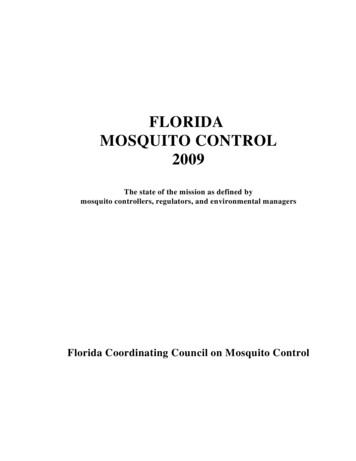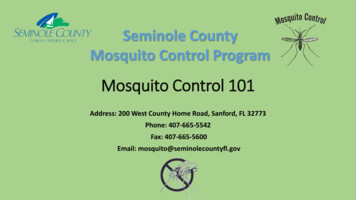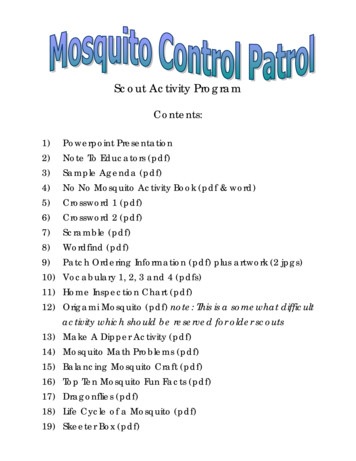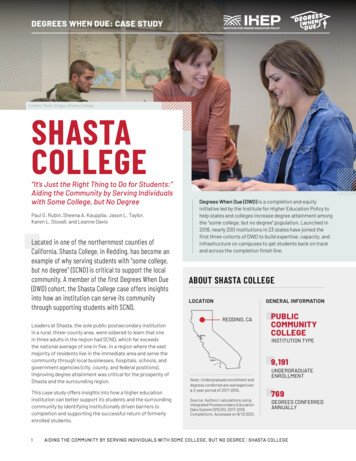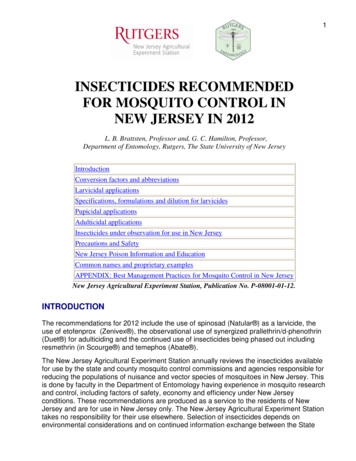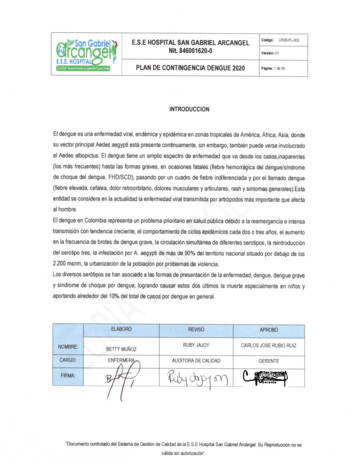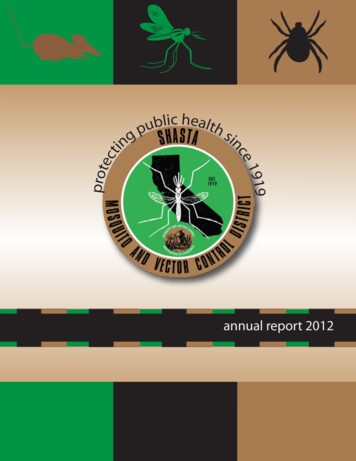
Transcription
protecti919e1nclic healthbupsignannual report 2012
FOREWARDSHASTA MOSQUITO AND VECTOR CONTROL DISTRICT19200 Latona Road, Anderson, CA 96007Telephone: (530) 365-3768Fax: (530) 365-0305Web: shastamosquito.orgTo the Residents of the Shasta Mosquito and Vector Control District:BOARD OFTRUSTEESPRESIDENTJohn C. DunlapSHASTA COUNTYVICE PRESIDENTLarry MowerAndersonSECRETARYStephen MorganSHASTA LAKETom MancusoREDDINGVickie MarlerSHASTA COUNTYADMINISTRATIONPeter BonkrudeManagerAs we come to the close of a very busy year, we often stop to reflect on the many thingsaccomplished. This year is marked by the response from mosquito and vector control officialslocally, statewide and nationally to the highest level of West Nile virus (WNv) human casessince 2003. Although Texas leads the country with 1,739 human cases, California came insecond, with 451 human WNv cases. With numbers that large it sometimes can be lost thatamongst those statistics people became ill, severely debilitated, and in the worst casessuccumbed to the illness. This year alone, we have seen 243 fatalities in the US. The strongrecurrence of WNv across the country showed that when the proper conditions exist, WNv isstill a severe public health threat.Even while busy combating WNv this season our staff has completed many successful projects. We completed and posted our Programmatic Environmental Impact Report whichhighlights that the District recognizes the balance between the highest levels of environmental stewardship and public health mosquito and vector control. We also hosted an openhouse at our District for National Mosquito Control and West Nile virus Awareness week.District staff enjoys showing the public the interesting and important work we do on a dailybasis. Finally the laboratory staff, in coordination with the operations staff, completed acomprehensive analysis of dusk versus dawn adult mosquito control efficacy and presentedthe information at the Mosquito and Vector Control Association of California Annual Conference.In addition to these District accomplishments; we have seen some significant changes inboth staff and leadership. This year we celebrated the career of our Operations SupervisorAudie Butcher; Audie spent over 30 years with the District and is largely responsible for theinnovative and efficient spirit that is apparent at Shasta Mosquito and Vector Control. Wethank Audie for his service and wish him the best as he enjoys his retirement. As we couldnever replace Audie, we reorganized the Operations Department and were lucky enough tohire Guangye Hu, PhD. to be Shasta MVCD’s new Assistant Manager. He brings with him adifferent perspective as he was the Manager of a county program in Florida. Additionally, wesaw a switch in Board leadership as Trustee Charles Ryan left and we welcomed Trustee TomMancuso a retired school administrator; he brings a wealth of experience to the District.Sincerely,Peter BonkrudeDistrict Manager2John Dunlap2012 President, Board of TrusteesOur Mission:”To protect the public’s health from vector-borne disease and nuisance, through a comprehensivemosquto and vector control program focused on innovation, experience and efficiency.”
BOARD OF TRUSTEESBoard TrusteeBoard Vice PresidentBoard PresidentVickie MarlerLarry MowerJohn DunlapShasta CountyAndersonShasta CountyBoard TrusteeBoard SecretaryStephen MorganShasta LakeTom MancusoReddingDistrict ManagerPeter fice AssistantVector ControlTechnicians(VCA, VCT 1, 2, 3)9 TotalVectorEcologistAssistantVector EcologistTHE STAFFBack Row:Audie ButcherAl ShabazianJoe MimbsMike AlexanderBetty WillisPeter BonkrudeKelly ClelandKevin PearsonGeoff TaylorFront Row:Corey BoyerCatherine HasherTim MickelaJohn AlbrightValerie PetersonKendraAngel-Adkinson3
DISTRICT HISTORYThe first local mosquito control district was formed in 1919 in the Redding area. Mosquitoes weretransmitting malaria, a mosquito borne disease that was prevalent in the region. The formation ofother districts in the Anderson and Cottonwood areas quickly followed. The Anderson, Cottonwood and Redding areas had some of the highest malaria rates in the continentalUnited States.Through the years, the local mosquito control districts evolved to meet the needsof the growing communities.In the mid 1950s, the three districts consolidated into one comprehensivedistrict. When it became necessary, the district expanded its boundaries toinclude surrounding areas; effectively providing public health protection to alarger number of Shasta County residents.Dipping formosquito larvae,1952In 2004 when West Nile virus (WNv) was first detected in Shasta County, theDistrict encompassed 384 square miles. Due to the need to provide protectionagainst WNv beyond those boundaries, the District was expanded through an election thatannexed and provided a benefit assessment to fund services in outlying areas. Today, ShastaMosquito and Vector Control District serves 1086 square miles of Shasta County.INTEGRATED VECTOR MANAGEMENTWhat’s a VectorA vector is an insect or living carrier that transmits an infectious agent.What is Integrated Vector Management (IVM)Shasta Mosquito and Vector Control utilizes an Integrated Vector Managementapproach to controlling mosquitoes within our District boundaries. IVM is definedas “a rational decision-making process for the optimal use of resources in themanagement of vector populations, so as to reduce or interrupt transmission ofvector-borne diseases.” (WHO)EmergingIts characteristic features include:Adult Selection of proven vector control methods based on knowledge of local vectorbiology and ecology, disease transmission and morbidity; Utilization of a range of interventions, separately or in combination and oftensynergistically; Collaboration within the health sector and with other public and private sectorsthat impact on vector breeding; Engagement with local communities and other stakeholders; A public health regulatory and legislative framework; Rational use of insecticides; Good managment practices.An IVM approach takes into account the available health infrastructure andresources and integrates all available and effective measures whether chemical, biological orenvironmental (WHO).4Adult MosquitoMosquito Life CycleMosquitoes undergo acomplete metamorphisisincluding eggs, larvae, pupaeand adult life-stages. Allmosquito life-stages exceptadults require standing waterto survive and develop.PupaLarvaEgg Rafts
WEST NILE VIRUS HISTORY1999West Nile virus was named for the location in which it was firstisolated, the West Nile region of Uganda. Although it wasdiscovered in 1937, its true potential for distribution and mortality went unrecognized for decades. By the mid-1990s, WestNile virus was on the move. Major epidemics appeared incountries such as Romania, Morocco, Tunisia and Israelbetween 1996 and 1998. In 1999, West Nile virus had made thejourney to North America arriving in New York City.From New York, West Nile virus made a steady progressionacross North America. By 2005, each state in the continental UShad experienced WNv infection either in animal or human.The virus first appeared in southern California in 2003. Thefollowing year, Shasta Mosquito discovered West Nile virusinfection within the District. Since this discovery, the Districtexpanded its boundaries to protect neighboring communitiessuch as Lakehead, Castella, Shingletown, Viola, Igo & Ono andexpanded surveillance for the virus.West Nile virus Reachesthe Northstate, July, 2004By September of 2004, the ShastaMosquito & Vector Control District hadsprayed 89,000 acres, compared to8,700 acres the previous year.WNv is a type of encephalitis (inflammation of thebrain) which severely affects horses and certaintypes of birds. Humans are also susceptible, andalthough symptoms are often undetected or verymild, death can occur.20045
WEST NILE VIRUS NATIONWIDE2012 West Nile virus Update:As of December 11, 2012, 48 states have reported West Nile virus infections in people, birds, or mosquitoes. A total of 5,387cases of West Nile virus disease in people, including 243 deaths, have been reported to CDC. Of these, 2,734 (51%) wereclassified as neuroinvasive disease (such as meningitis or encephalitis) and 2,653 (49%) were classified as non-neuroinvasivedisease.The 5,387 cases reported thus far in 2012 is the highest number of West Nile virus disease cases reported to CDC through thesecond week in December since 2003. Eighty percent of the cases have been reported from 13 states (Texas, California, Louisiana, Illinois, Mississippi, South Dakota, Michigan, Oklahoma, Nebraska, Colorado, Arizona, Ohio, and New York) and a third ofall cases have been reported from Texas.West Nile virus (WNV) activity reported to Arbonet, bystate, United States, 2012 (as of December 11, 2012)NeTexasWesartNUlyile90Pu pda0cbl tecaish d:asseesed Thsdre: T ursoupohu dablrtersd y, 3eiday 0 Anin,3 u2sta0A g2wteeeug 01thks20 2, 1isye12 2:ar, 9 55:02 PMAM CDCD TTIt's mosquito season, and thatmeans that West Nile virus isback. The Midwest outbreakthis summer is the worst in U.S.history, with 50 deaths so far inTexas alone. Fewer peoplehave gotten sick in California,but the disease showed uphere earlier than usual. Andscientists are concerned that asthe climate warms, West Nileand other mosquito-borneillnesses will gain a strongerfoothold here.Reporter: Molly SamuelSeptember 12, 20126Puan blicou nou hetb n a012U2,.S. rea ced lth o11 eases und inrhelboist k w th fficBytem ress Re Virus For as at ialpeSPy.N i Seile7sh thi s thD0N0Cptl2sap s y isre e d teSMV of We Sincepo is min ea pasayltg r’s sebennrvaueteup W t sdoLeCstd se, r 4,Paetshrto est umta8enoh7HigSve tbe N mnt he end earlth ile erio Ce in y 2ewn.0gnt00ioregnnrsst012 ction k to beifo dea case2in,5ecr1tsasrrhbDbe wsSurs, h ofntioaotseckyea ad WOileANe tbrease b esiousest NWJAVM Nile ou istory ing prevCo ee te:lthlinTktehcnt nst)daeSnPnW t in Uco(Arot a theutp , 2012eScloecNfieslArt ORLEA s to in ar forwor tion rat tober 3.2eue0yWccn0tEieOst2fNrnnInwoinces coolened oviru le in the isiana sPost Scott Nup.peo se in LoBy Raesid
WEST NILE VIRUS STATEWIDEDelNorteSiskiyouWest Nile Virus ActivityModocShastaLassen1TrinityHumboldtWest NileTotal # of Neuroinvasive West Nile Other/ Human Dead birds16442012476308160747Mosquito pools2849201115811147018Sentinel Updated 2/11/132008445293148453N 31 counties2007380156220430with oSolanoAlpineadorAm294 inSan Franciscoto10cramenNapaEl DoradoSaSonomaMercedM131SantaCruzHuman Casesin California Counties2012 latedFatalities1291996415217192903San LuisObispoThis year, similar to the entire country, California saw resurgence inWest Nile virus cases statewide. The CA Mosquito Districts appliedproactive Integrated Vector Management techniques andalthough had the second most human West Nile cases nationwide,still managed to keep rates per 100,000 people lower than moststates hit hard by West Nile virus.Kern25San BernardinoSantaBarbara32Ventura7LosAngelesCounties with West Nilevirus activity (no humancases)Counties with West Nile virus activity(number of human cases)163Orang42Riversidee19San Diego1Imperial1WEST NILE VIRUS SMVCDWest Nile virusPositive CasesBirds - 36Chickens - 6Horses- 4Humans - 13Mosquito samples - 17Squirrels - 1144211Locally, the Shasta Mosquitoand Vector Control Districtexperienced the highestlevels of West Nile virusevidence since 2007. Thislevel of WNv meant that theDistrict responded in fullforce treating 5 times thelevel of larval control treatments and over 100 moreadult mosquito controlapplications when compared to 2011. We expectnext year to be similar to theone we just experienced, soearly on staff will beginaggressively treating theareas that have mosquitoespresent.17
SERVICE REQUESTSEach year the District receiveshundreds of requests forservices. These calls can be forfree mosquito fish delivery,dead bird calls, insect identification, and issues with bitingadult mosquitoes. Districtpersonnel routinely inspect andtreat thousands of recordedmosquito sources, but newsources are constantly beingfound or created. These calls arean important source of information on new mosquitoproblems and a means ofpreventing mosquito production. Members of the public areencouraged to call or submit aservice request online. Everyeffort is made to rapidlyrespond to these calls, usuallyon the next business day.2012 Service RequestsNumber ofRequestsRequests ReasonMosquito Service RequestsMosquito Fish RequestsNeglected Pool RequestsDead Bird Requests3544298998TOTAL970Shasta, 4This map is an image of theDistrict’s mosquito operatingsystem. The District is dividedinto zones and each one isassigned to a service technician.The red telephone icon indicateswhere a service request has beengenerated.Shingletown, 31Anderson, 158Number ofService Requestsby CommunityBella Vista, 16Redding, 471Castella, 1City of ShastaLake, 43Cottonwood, 60Enterprise, 25French Gulch, 3Igo, 8Palo Cedro, 36Ono, 2Mountaingate , 18Lakehead, 8Millville, 14Happy Valley, 39Jones Valley, 1
NEGLECTED POOLSNeglected pools typically containabundant organic matter or bacterialgrowth, often with leaves or otherdebris, resulting in green to blackishcolored water. These pools are notproperly maintained with filtrationand chemicals and are generallyneglected by the property owner.Thousands of unmaintained swimming pools across District boundariesassociated with the nationwideforeclosure crisis continue to be afocus of the Shasta Mosquito and VectorControl District because of their ability toproduce mosquitoes capable of spreading disease including West Nile virus. Justone swimming pool can produce morethan one million mosquitoes and affectpeople up to five miles away.2012 Reported PoolsBiological ControlChemical ControlCleanDry2012 Aerial Pool ProgramBiological ControlChemical ControlCleanDry2012 Neglected Pool ProgramAerial Surveillance IdentifiedService Request IdentifiedResolution63153081533624163Biological ControlChemical ControlCleanDry53975TOTAL9
BIOLOGICAL CONTROLBiological control of mosquitoes range from naturally occurringorganisms such as birds, bats, fish, dragonflies, copepods andmosquito larvae. In an Integrated Vector Management Program,biological control of mosquitoes is an integral component.Biological control is based on the introduction of organisms thatprey upon, parasitize, compete with or otherwise reduce populations of the target species.Visitors at the District’sfish rearing pondMosquito FishGambusia affinisThe Shasta Mosquito and Vector Control District currentlyutilizes the most successful biological tool against larval orimmature mosquitoes; Gambusia affinis or better known to thepublic as mosquito fish.District staff will deliver and stock Gambusia affinis in watersources throughout the District. This includes ornamental ponds,natural ponds, waste water treatment plants, stock ponds, watertroughs and other water features. The District received 429mosquito fish requests; over 50,000 fish were planted in 2012.The mosquito fish is a small guppy-likefish used to control mosquito larvae.The fish have a large appetite, and asingle female (which normally is largerthan a male) can devour severalhundred mosquito larvae per day.The fish are hardy and can live in manytypes of water habitats for severalyears. If added to ornamental ponds,they are compatible with gold fish,carp and koi. However, they are notcompatible with bass, bluegill, catfish,perch, turtles, crayfish and frogs.Gambusia can reproduce rapidly andare unlike other fish in that they donot lay eggs; they bear live young.Each female can produce three or fourbroods in her lifetime, and each broodcan vary from 40 to 100 young. Birthusually occcurs during the warmspring and summer months. When theyoung (about 3/8”long) are born, theyare active and immediately swim forthe nearest cover and will soon feed.10These photos are an example ofwater sources in the District wheremosquito fish can be used
PHYSICAL CONTROLPhysical Control, sometimes referred to assource reduction, is a critical component of anIntegrated Vector Management Program. Thiscontrol measure can be as simple as turningover a bucket or as involved as using heavyequipment to clear a network of drainageditches. This goal is simple, to eliminate orreduce the number, size and frequency ofmosquito breeding sites. Over the yearsShasta MVCD has employed physical controlquite successfully.Physical control involves clearing vegetation around or near watersources to improve drainage and provide access for other types ofmosquito control. The District works with the local California Department of Fish & Game and other agencies in physical control.CHEMICAL CONTROLChemical Control measures are one part of a comprehensive and Integrated VectorManagement Program. Control measures, including the decision to use chemicaladulticides and larvicides, should be based on surveillance data and the risk ofhuman disease. Larvicides are products used to kill immature mosquitoes (in thewater) before they become adults. They can be either biological or chemical products, such as insect growth regulators, surface films, or organophosphates. Larvicides are applied directly to water sources that hold mosquito eggs or larvae. Whenused effectively, larvicides can help reduce the overall mosquito burden by limitingthe number of new mosquitoes that are producers. Adulticides are products usedto kill adult mosquitoes and are typically applied from truck-mounted sprayers.They can have an immediate impact to reduce the number of adult mosquitoes inan area, with the goal of reducing the number of mosquitoes that can bite peopleand possibly transmit mosquito-borne diseases like West Nile virus. Both larvicidesand adulticides are regulated by the US Environmental Protection Agency.Chemical applicationequipmentTruck mountedadulticide sprayerLarvicide treatment at lumbermills with a Maruyama backpack granular applicator11
LARVAL & IMMATURE CONTROLMosquito Control technicians regularlyinspect mosquito sources throughoutthe District. The photos show a dipperthat is used to check for mosquito larvae.This dipper was filled with larvae from atreehole in December. The larvae willmost likely hatch in the spring.Immature Mosquito ControlTechnician dippingfor mosquito larvaeTreeholeTreehole filled with larvaeImmature Mosquito ControlCommunityApplicationsEst. AcresTreatedAndersonBella VistaCastellaCity of ShastaLakeCottonwoodEnterpriseFrench GulchHappy ValleyIgoJones ValleyLakeheadMillvilleMountain GatePalo CedroReddingShastaShingletownSummit t Control12Larval ControlMosquito larvae and pupae
at is NPDEWater QualityMonitoringS?WhADULT CONTROLAdult Mosquito ControlMilesDrivenEst. 763Bella Vista7612,250CastellaCity of nterprise4755420,525Happy ville448Mountain 8The National Pollutant Discharge Elimination System (NPDES)permit is a permit that authorizes a person, agency or corporation to release "pollutants" into a public waterway (Water of theUS). Public Health pesticide applications have never fallenunder this category until a 6th circuit court decision in 2009.Instead of only being regulated by FIFRA (the Federal Insecticide, Fungicide, and Rodenticide Act) we are now being regulated again under the Clean Water Act and the California StateWater Resource Control Board. This permit brought with itmany costly and labor intensive requirements. These includevisual monitoring of pesticide applications, which takes criticaltime away from Vector Control professionals protecting thepublic we serve.OTHER VECTORSThe District began its tick surveillance program in 2009. Twenty locations throughout the District are sampled on aweekly basis between November and March. Ticks are collected in vegetation along trails and at the interfaces betweenhabitat types (ecotones). In 2012, the District modified two and added one sampling site. Ixodes pacificus ticks were sentto Shasta County Public Health for testing. Of the 128 samples submitted, 5 samples from 2 locations were positive forBorrelia spp. bacteria. More samples from 2012 are still pending submission and testing.Dr. Hu surveying for ticksAmericanDog tickIn the vialWestern BlackLegged ticks13
RESEARCHVector ecology is a dynamic field of study that isaffected by advances in diagnostic methods, development or lack of new control products and techniques,regional environmental conditions, introduction ofnew species and diseases, short term weather conditions and long-range changes in climate. In additionto the routine compilation of statistics on past andcurrent mosquito populations and disease transmission, the District undertakes short and long-termresearch projects to assess and develop strategies todeal with important factors such as the developmentof pesticide resistance in local mosquitoes, and assessing and improving the efficiency and effectiveness ofcontrol methods.Morning ULV applicationEvening ULV applicationThe District is in its second season of trying toassess the comparative effectiveness of ultralow volume (ULV) applications of pesticides tocontrol adult mosquitoes depending onwhether applications occur in the morning orthe evening. Between May 15 and August 30,2012 sixty-one ULV treatment events weremonitored. Of these, 32 were in the eveningand 29 were morning treatments. Mosquitotraps were set the evening before and theevening after each treatment occurred, and thenumber of mosquitoes caught pre- and posttreatment was compared to assess the extent towhich the population was reduced by each ULVapplication. On the average mosquito populations were reduced by approximately 52.8%compared to 52.4% for morning and eveningtreatments respectively.Percent Mosquito Population Reduction Following Adulticide Treatment(Averages by Month of 29 Morning and 32 Evening Treatments in 2012Average
RESEARCHAnother experiment was done to assess whether ultralow volume (ULV) applications of larval control productscould be applied as very fine aerosols to drift into thickvegetation and control mosquitoes larvae in crypticsources such as treeholes and standing water sourceshidden beneath dense undergrowth. Plastic cups withmosquito larvae were distributed in a grid patternthroughout a dense stand of scrub oak trees. A truckmounted ULV device was used to dispense a larvalcontrol product into the air drifting through the oakgrove. Despite very serious problems with the equipment and low wind speed, significant mortalityoccurred in larvae in the cups within the grid.District staff monitor weather conditionsbefore an experimental larvicide treatmentAe. sierrensis AKA “treehole mosquitoes”male (left) and female (right)The District also provides assistance to outside researchers when requested and as timepermits. In 2012 local mosquitoes were sent to the University of California at Davis andthe U.S. Department of Agriculture for studies of mosquito behavior and genetics.15
VECTOR & DISEASE SURVEILLANCEOne of the most essential components of a successful Integrated Vector Managment Program is the surveillance of vectors and the diseases they transmit. Therisk of discomfort and/or disease transmission by mosquitoes within the Districtdepends on space, time and the prevalence of certain species of mosquitoes andincidence of disease. By effectively monitoring the abundance of vectors and theoccurrence of disease, the District is better able to direct its operations andprovide efficacious and focused public health intervention. Historically malaria,Saint Louis encephalitis, western equine encephalomyelitis, canine heartwormand West Nile virus have been transmitted by mosquitoes within the District. Thisyear the District utilized two trap types to gather abundance and disease data;New Jersey light traps and encephalitis virus surveillance (EVS) traps.Tota2l adult m 012 Mosqosquitoes p uito Per wopueekin 2 lation1 New JerseyAprMayJunJulAugSepLight TrapsOc tNew Jersey light trapcollecting unsuspectingmosquitoes drawn to thelightNEW JERSEY LIGHT TRAPSNew Jersey light traps are set at21 fixed locations throughoutthe District. Mosquitoes fromthese traps are collected weekly,and then sorted by species andsex. Mosquito population datafrom these traps is used toassess pest and disease riskposed by mosquitoes in differentareas of the District.EVS TRAPSEncephalitis virus surveillance (EVS) traps are another means tomonitor mosquito population. EVS traps are set for one night ateach of the 27 fixed locations throughout the District. The followingmorning they are collected, counted and identified. In addition tothe fixed locations, staff place variable or “floating” trap sites on anas-needed basis. In 2012, there were 89 unique “floating” trap locations used.Mosquitoes of the appropriate species collected from EVS traps aresubmitted to UC Davis to be tested for the presence of infectiousagents. In 2012, the District submitted 679 samples, far surpassingthe number of samples from 2011 (389) and 2010 (325). There were17 samples which were positive for West Nile virus.16EVS capturedmosquitoes awaitsortingEncephalitis virussurveillance trap
VECTOR & DISEASE SURVEILLANCESENTINEL CHICKENSBirds are important reservoir hosts of severalmosquito-borne diseases. Unlike crows or magpies,chickens infected with West Nile virus (WNv) rarelyexperience any adverse effects from the virus andmake excellent sentinels. Chicken flocks generallyconsist of 10 birds at five locations. The District takessmall samples of blood from the birds every twoweeks from mid-April through mid-October. Theblood samples are then shipped to a public healthlab in Richmond where they are tested. In 2012, sixchickens from three different flocks had acquiredWNv infections.Corvids can be tested inthe District’s labDEAD BIRD SURVEILLANCEWest Nile virus (WNv) often kills infected birds, especiallycorvids such as crows and magpies. Recently deceasedbirds are tested for WNv and other viruses. Positivesamples indicate active virus transmission in the generalarea and closer inspection or treatment may be necessary.Residents reported 260 dead birds to the District and theWNv hotline. Further testing resulted in the detection ofWNv infection in 36 birds from various areas of the District.Sentinel chickensght in 2012mosquitoes caullafondowBreakAedes spp3101Culiseta spp2519Anopheles spp18192012Adult M MosquitoosquitoPes per W opulationsbeek in 27 CO2 b y Genusaited EVS Traps2500200015001000Culex spp341545000AprAnophelesCulisetaAedesCulexMayGenus significanceJunJ ulAugSepOc tCulex spp- West Nile & encephalitis virusesCuliseta spp- pestAnopheles spp- malaria vectorAedes spp- dog heartworm, severe pest,encephalitis virusesALL can be MAJOR PESTS in high numbers!17
OUTREACHPublic information is a key component in any IntegratedVector Management Program. The Shasta Mosquito & VectorControl District strives to educate District residents through avariety of media.Online @ www.shastamosquito.orgThe District website providesinformation and service 24/7.Visitors can find details onscheduled adult mosquitocontrol applications, requestan inspection for their homesand report dead birds.Other links include information on non-mosquito vectors,vector borne diseases, Boardagendas and minutes.ClassroomPresentation byour VectorEcologistWebsite Traffic in 20124,198 visits2,234 guests12,212 viewsenres givrochu ventsbfous edownBreak ublic at vario s total )preout to ,189 brochu3(2012 District Press ReleasesPublic EventsDistrict staff participated inmore than 20 events orpresentations in 2012. Someof the newest events theDistrict has attended include:Shasta DistrictFair1,173517AndersonHome &Garden Show439Redding Home& Garden ShowAll OtherEvents1,060-Love your Pet ExpoNorcal Boat, Sport & RV showRedding Rancheria Earth Day FairRedding Rancheria Health FairWhole Earth & Watershed Day FestivalLocal MediaThe District has over fifty print brochures on a variety of topicsconcerning mosquito and vector control. Brochures are available atthe District office and public events the District attends. SMVCDissued press releases on several topics, including increased regulation affecting mosquito control, events the District attended andthe high level of West Nile virus activity. These press releasessparked further interest in District operations, resulting in articles inthe Record Searchlight, A News Cafe (www.anewscafe.com), andseveral interviews on KQMS radio with the Vector Ecologist.18Open House 2012Refreshments & Tours02/02/2012Federal order impedes publichealth mosquito control08/10/2012First indication of West Nile virusin Shasta County08/23/2012Shasta County continues West Nilevirus positives with first dead birdsand additional infectedmosquitoes09/11/2012Highest levels of West Nile virusfound in Shasta County since 200710/04/2012First Human West Nile case inShasta County10/19/2012West Nile virus activity persists asmosquito season winds down
FINANCIAL HIGHLIGHTSStatement of Financial Position: FY2011-2012 (June 30, 2012)2010-2011AssetsCash and cash equivalentsRestricted cash
Locally, the Shasta Mosquito and Vector Control District experienced the highest levels of West Nile virus evidence since 2007. This level of WNv meant that the District responded in full force treating 5 times the level of larval control treat-ments and over 100 more adult mosquito control applications when com-pared to 2011. We expect


